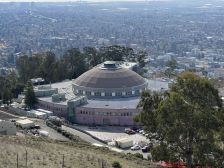National Science Foundation breaks ground on computing facility in Texas

A computing facility being built by the National Science Foundation in Texas aims to advance computational research and development through new hardware, software and other services that will be available to scientists across the country, the agency said.
NSF on Thursday announced it had started construction on the Leadership-Class Computing Facility, which will be led by the University of Texas at Austin. That facility is expected to be operational in 2026 and will be home to Horizon, NSF’s “largest academic supercomputer dedicated to open-scientific research.”
“This facility will provide the computational resources necessary to address some of the most pressing challenges of our time, enabling researchers to push the boundaries of what is possible,” NSF Director Sethuraman Panchanathan said in a written statement.
Horizon is expected to improve performance for simulations by 10 times over Frontera, the agency’s current “leadership-class computing system,” which is also located at the university’s Texas Advanced Computing Center, according to the release.
A spokesperson said leadership-class computing is one of three complementary advanced computing areas in which NSF invests. The other two are advanced/innovative computing systems and services, and coordination and support services. The Texas facility is the second phase of NSF’s Frontera project that started in 2019, an NSF spokesperson said.
Horizon also promises more capability for AI research, per a press release from the agency.
“For AI applications, the leap forward will be even larger, with more than 100x improvement over Frontera,” the release said. “Horizon will include a significant investment in specialized accelerators to enable state-of-the-art AI research and more general-purpose processors to support the diverse needs for simulation-based inquiry across all scientific disciplines.”
As a result, the computing facility is also expected to be an important part of the National AI Research Resource, or NAIRR, which is currently in a pilot phase. The NAIRR is meant to provide students and researchers with computational and data resources needed for their work.
UT Austin President Jay Hartzell said in a written statement that the university and its advanced computing center are recognized as “one of the nation’s leading academic supercomputing centers” and the new facility means “continued excellence and reliability for top researchers from across the country.”
“This investment will enable UT to make even greater impacts by addressing more challenges using AI, computational science, and other disciplines,” Hartzell said. “We are excited about the privilege to continue in our role as an enabler of work that serves and improves society, and we are grateful to NSF and to our longtime partner in advanced computing, Dell Technologies.”
According to a release from UT Austin, NSF’s initial investment for construction is $457 million. In that release, Hartzell also thanked Rep. John Carter, R-Texas, for helping secure the funding.
The Texas facility will also collaborate with four “distributed science centers” to broaden its access, distribute “storage and capabilities across the country,” and leverage “the expertise that exists at the centers,” the NSF spokesperson said.
Those four organizations are the Atlanta University Center Consortium, which is composed of four historically Black colleges and universities; the National Center for Supercomputing Applications at the University of Illinois Urbana-Champaign; the Pittsburgh Supercomputing Center at Carnegie Mellon University; and the San Diego Supercomputer Center at the University of California San Diego.
In addition to those organizations, Ohio State University will also contribute to “advancing the software stack for high-performance networking” and Cornell University will assist with workforce development, the NSF release said.






